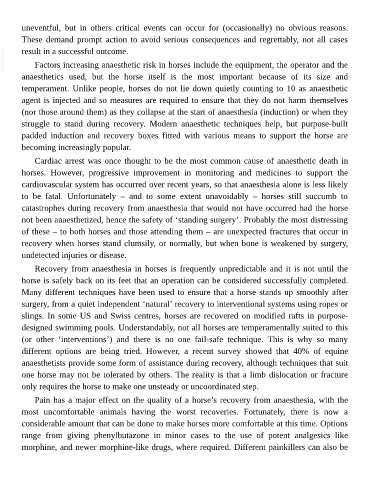Page 1088 - The Veterinary Care of the Horse
P. 1088
uneventful, but in others critical events can occur for (occasionally) no obvious reasons.
These demand prompt action to avoid serious consequences and regrettably, not all cases
VetBooks.ir result in a successful outcome.
Factors increasing anaesthetic risk in horses include the equipment, the operator and the
anaesthetics used, but the horse itself is the most important because of its size and
temperament. Unlike people, horses do not lie down quietly counting to 10 as anaesthetic
agent is injected and so measures are required to ensure that they do not harm themselves
(nor those around them) as they collapse at the start of anaesthesia (induction) or when they
struggle to stand during recovery. Modern anaesthetic techniques help, but purpose-built
padded induction and recovery boxes fitted with various means to support the horse are
becoming increasingly popular.
Cardiac arrest was once thought to be the most common cause of anaesthetic death in
horses. However, progressive improvement in monitoring and medicines to support the
cardiovascular system has occurred over recent years, so that anaesthesia alone is less likely
to be fatal. Unfortunately – and to some extent unavoidably – horses still succumb to
catastrophes during recovery from anaesthesia that would not have occurred had the horse
not been anaesthetized, hence the safety of ‘standing surgery’. Probably the most distressing
of these – to both horses and those attending them – are unexpected fractures that occur in
recovery when horses stand clumsily, or normally, but when bone is weakened by surgery,
undetected injuries or disease.
Recovery from anaesthesia in horses is frequently unpredictable and it is not until the
horse is safely back on its feet that an operation can be considered successfully completed.
Many different techniques have been used to ensure that a horse stands up smoothly after
surgery, from a quiet independent ‘natural’ recovery to interventional systems using ropes or
slings. In some US and Swiss centres, horses are recovered on modified rafts in purpose-
designed swimming pools. Understandably, not all horses are temperamentally suited to this
(or other ‘interventions’) and there is no one fail-safe technique. This is why so many
different options are being tried. However, a recent survey showed that 40% of equine
anaesthetists provide some form of assistance during recovery, although techniques that suit
one horse may not be tolerated by others. The reality is that a limb dislocation or fracture
only requires the horse to make one unsteady or uncoordinated step.
Pain has a major effect on the quality of a horse’s recovery from anaesthesia, with the
most uncomfortable animals having the worst recoveries. Fortunately, there is now a
considerable amount that can be done to make horses more comfortable at this time. Options
range from giving phenylbutazone in minor cases to the use of potent analgesics like
morphine, and newer morphine-like drugs, where required. Different painkillers can also be

